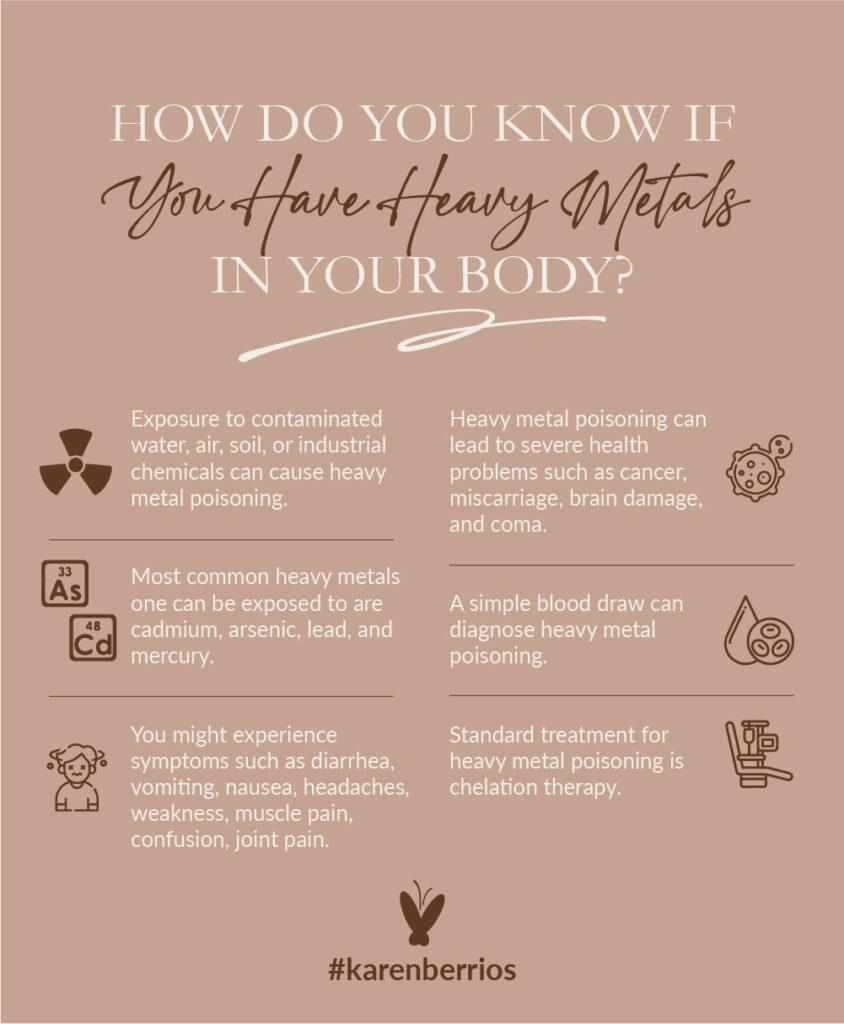

How Do You Know if You Have Heavy Metals in Your Body?
Metals in Your Body. Some illnesses and disorders are caused by bacteria, some by viruses, and some by environmental toxins and heavy metals. Heavy metal poisoning is a serious condition that can lead to a variety of issues, some of them being pretty severe.
Heavy metals are usually found in the earth, but your body also naturally contains some of them. Heavy metal poisoning occurs when your body absorbs too much of a particular metal or a variety of metals which can cause inflammation, hormonal imbalance, indigestion, and even miscarriage or brain disorders.
Everyone needs zinc, iron, copper, and other similar metals for optimal function of their body function, but there are other heavy metals that can create serious health problems when absorbed in toxic amounts.
Heavy Metals Your Body Can Absorb in Toxic Amounts
Even though there are plenty of heavy metals out there, your body usually absorbs the ones found in the water, soil, air, industrial chemicals, and even items you use on a daily basis like food packaging and paint. The most common heavy metals you can get from chronic exposure are:
- Mercury
- Cadmium
- Arsenic
- Lead
Signs and Symptoms of Heavy Metal Poisoning
Depending on the heavy metal in case, the symptoms and signs of heavy metal poisoning can significantly vary. And even then, the duration and severity of the symptoms can show up differently in different people. The National Organization for Rare Disorders (NORD) states that with arsenic and lead exposure, symptoms may not show up for two to eight weeks, while in the case of cadmium, they might be noticed in the span of a few hours.
That being said, the most common symptoms include:
- Diarrhea
- Vomiting
- Abdominal pain
- Headaches
- Nausea
- Confusion
- Weakness
- Muscle pain
- Joint pain
- Chills
- Shortness of breath and breathing issues
- Tingling in hands and feet
The greatest problem with heavy metal poisoning is that it encompasses a large variety of symptoms that can also be signs of other health issues, making it harder to notice or diagnose.
In the case of more severe heavy metal toxicity, additional symptoms like aggressiveness, anemia, memory loss, brain damage, high blood pressure, unusual heart rhythm, warts or lesions on the skin, seizures, and even coma can occur. However, these instances are really rare, and the exposure to a certain heavy metal (or a mix of them) would have to be extremely high.
How Do You Get Exposed to Heavy Metals?
Heavy metals are everywhere around us. They’re in the water, the soil, the air, industrial chemicals like pesticides and herbicides, food packaging, medicines, cigarettes, lead-based paint, skincare and cosmetics, cleaning supplies, hair dyes, and others.
Some people can be at a higher risk than others, especially if they’re working in an industrial setting, doing construction work, working in a mine, manufacturing items like X-ray machines and mirrors, working with lead-based paint, or being exposed to a hazardous waste site.
Heavy metal poisoning is a result of a highly toxic accumulation of these metals, which then compete with and replace certain essential minerals in the human body. Consequently, several of your body’s organ systems may be affected, leading to improper function and inflammation. Heavy metals in the body wreak havoc that can sometimes be really hard to revert, and that’s why becoming more aware of our exposure is so crucial for our overall health and wellbeing.
In the past years, there have been outbreaks of heavy metal poisoning in the United States caused by imported plates and cookware that was not properly coated so it led to food contamination.
Heavy Metals and Cancer
There is now plenty of research that connects heavy metal toxicity with cancer developments, with an increased concern surrounding the levels of heavy metal exposure in our everyday life. Some of these include:
- Aluminum – which can be found in a variety of products from deodorant to kitchen supplies
- Arsenic – the contact with arsenic usually occurs through ingesting contaminated food and water, occupational exposure, and environmental pollution
- Beryllium – mostly used in industrial processes and technology production
- Cadmium – the exposure to cadmium usually occurs through the emissions from mining, metal research, development of certain batteries, and preventing precipitation in pigments
- Lead – mostly found in the soil and aviation fuel
- Mercury – usually found in thermometers, fossil fuel emissions, dental fillings, certain batteries, and burning medical waste
- Nickel – most common in mining, metal alloys, and the refinement of nickel
- Radium – the contact with radium usually occurs in coal mines and water systems

How Do You Test and Diagnose Heavy Metal Poisoning?
It’s actually pretty easy to check for heavy metal poisoning. All it takes is one simple blood draw and it’s known as a heavy metals panel or heavy metal toxicity test. If you know you’ve been exposed to a high level of heavy metals and you’re concerned you might have developed symptoms of heavy metals poisoning, share that information with your doctor and ask him to order the test for you. It should be covered with most insurance plans.
Still, additional tests may be necessary. These can include:
- Liver function tests
- Kidney function tests
- Hair and urine analysis
- Fingernail analysis
- X-rays
- Electrocardiogram
What’s The Standard Treatment for Heavy Metal Poisoning?
First and foremost, it’s important to avoid getting overexposed with heavy metals. This might mean taking some time off work or asking to be transferred to a different position, or even simply changing your diet and limiting the amount of wild caught fish. This alone can already be enough to treat heavy metal toxicity as your body gets back to a balanced state.
In the case of more severe heavy metal poisoning, the standard treatment is chelation therapy. Chelation agents have the ability to bind to heavy metals in the human body. When bound, they form complex structures which are then easily excreted from the body.
For a long time, a chelation agent 2,3-Dimercaprol has been used to treat arsenic or lead poisoning, but it came with serious side effects. That’s what made researchers take it a step further and discover new chelating agents that could be more effective for heavy metals poisoning. These include Calcium Disodium Ethylenediamine Tetraacetic Acid (CaNa2EDTA), Calcium Trisodium DTPA, D-Penicillamine, Meso-2,3-Dimercaptosuccinic Acid (DMSA), and others.
Final Thoughts
Heavy metal poisoning is rare, especially in the United States, but it’s a condition that’s important to diagnose and treat as the consequences can be severe. The chronic exposure to pollution is making it almost impossible to avoid being in contact with heavy metals, and it’s up to each and every one of us to do our due diligence and bring that exposure to the lowest possible level.

hey there
I'm Karen!
I have found my cancer journey to be a positive and profound transformational experience. I’m inspired to share my healing journey here, and trust you’ll find hope, encouragement and purpose as you discover the healing power that lies within you.
Join
The Mailing List!
By signing up for my newsletter, you agree with our Privacy Policy and Terms & Conditions.


